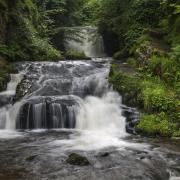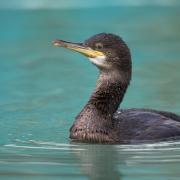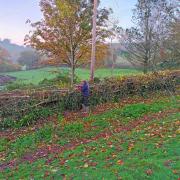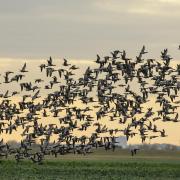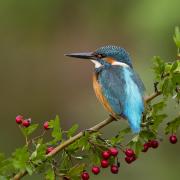Devon Wildlife Trust's Steve Hussey looks at the enduring fascination of rockpooling
The same scene will be played out along the coastline of Devon this summer. Kids, tired of their own voices asking ‘are we nearly there yet?’ will burst from over-full family cars, sprint across sand and into the sea. But there’s only so long that children can stay in the surf. Even a wetsuit’s protection doesn’t last forever – bodies chill, skin wrinkles and extremities numb! Before long the pull of a warm, dry towel becomes overwhelming. It’s then that parents will be glad of the rockpools that surround many Devon beaches.
Rockpooling has enduring appeal. It may not offer the same adrenaline-fuelled rush as riding the surf, but the sense of exploration, discovery and wonder that it provides captivates young minds keeping them occupied for hours. But rockpooling is important for another reason, too. It provides an early and compelling lesson into the beauty and richness of our local marine wildlife. For most, the secrets of the deeper ocean will lie, literaly, out of our depth, a fascinating other-world only glimpsed in TV documentaries. Rockpools provide a window into this marine world and one that has the added bonus of not requiring expensive equipment – a bucket and a pair of beach shoes is all you’ll need. The only cost for taking part in this magical exploration is likely to be wet feet.
Rockpooling provides an early and compelling lesson into the beauty and richness of our local marine wildlife
So what wildlife can you expect to see in a Devon rockpool this summer?Beadlet anemones are common and easy to spot. As the tide goes out, it clings to rocks, looking like a small blob of red jelly. But as the tide returns, it comes to life, transforming into a mass of waving tentacles. These tentacles hold stinging cells which, although harmless to humans, pack a punch capable of subduing prey thesize of a shrimp. Beadlet anemones also use their stings to battle with one another for the top feeding spots in the rockpool.
Other anemones worth looking out for include the snakelocks anemone, whose green tentacles show purple tips, and, in deeper pools, the strawberry anemone which looks like a... well, I’m sure you can guess for yourselves.
If you catch sight of a sudden, darting movement in the rockpool, it’s likely to have been a shanny. This common little fish is shy and will hide in a rock crevice at the first sign of trouble. It is also something of a master of disguise, having the ability to match its skin colours to the rockpool background it finds itself in. Perhaps partly because of their retiring nature, the shanny is long-lived, capable of reaching the grand old age of 15 years.
Feisty is the best description for another common rockpool resident – the shore crab. Despite being small, shore crabs seem to enjoy a scrap; they’ll fight with each other, and you given the chance. A few minutes looking beneath rockpool boulders and stones will often reveal a lurking shore crab.
A pair of bright red eyes is the tell-tale sign that you’ve come face-to-face with a velvet swimming crab. On closer inspection, you’ll see the crab’s covering of fine hairs which give it its name.
With as many as 14 arms, the common sunstar is one of the most feared predators of the seabed, armed to the teeth and capable of crunching their way through a diet of other starfish and tasty-sounding sea cucumbers. This is one of the UK’s most stunning starfish.
The limpet’s reputation as a dogged and unmoving presence is unjustified. As the tide comes in, limpets become uncharacteristically agile, roaming shoreline rocks to graze on algae, leaving a slimy trail behind them as they as they go. But as the tide goes out, they run the risk of drying out. To remain moist, each limpet returns to its ‘home scar’, a round groove in the rock made to match its own shell. This allows a perfect seal to be made against the sun and wind. But how can an animal with no eyes find its way home at the end of each high tide? The answer lies in its slime. The limpet ‘reads’ the signals left in this trail to find its home scar each time.
Mussels are another common rockpool find. They secure themselves to rocks using hundreds of tiny, sticky threads. Colonies of mussels will often completely cover large rocks providing a rich protein-packed larder for local wildlife. It’s not just people that enjoy eating mussels – their long list of predators includes oystercatchers, crabs, starfish and dog-whelks.
Where to Rockpool in DevonWembury, near Plymouth TV wildlife presenter Bill Oddie voted this south coast spot near Plymouth his favourite for rockpooling in the UK. Sightings of shore crabs and porcelain crabs are guaranteed. Also look out for common prawns, cushion stars and starfish. Wembury also has its own Marine Centre showcasing the best of local wildlife. Regular guided rockpool rambles are provided by the centre’s expert staff throughout the summer. Find out more at wemburymarinecentre.orgGoodrington Sands, PaigntonGood rockpooling can be had in Torbay. Look out for the Seashore Centre and its regular guided rockpool rambles (open in school holidays, 10am-4pm). Lee Bay, near IlfracombeThis small bay offers some of the best rockpooling in north Devon. At low tide, a scramble around the eastern edge of the bay leads to some wonderful seaweed-covered pools.Barricane Beach, Woolacombe Amid the surfers and sunbathers there’s excellent rockpooling to be explored either end of this popular beach.
What to take with you?• A bucket is useful to get a closer look at your finds. Remember not to put more than one creature in a bucket at a time (you may be introducing a predator to its prey), and always put creatures back where you found them. • I always take an identification guide. Paul Naylor’s Great British Marine Animals is written by a very knowledgeable, local marine wildlife expert and makes the perfect companion.• A pair of polarising sunglasses is also useful. On a sunny day these will allow you to see through the surface sheen of pool to the water and wildlife below. • Beach shoes are also a good idea, providing grip on slippery rockpool surfaces.
Marine wildlife needs youThe Wildlife Trusts are launching a new campaign called ‘Petition Fish’ to put pressure on the UK Governments to provide better protection for our seas. By the end of 2012, a network of marine protected areas will be created around the UK. But we are concerned about these areas – about the level of protection they will offer to our precious marine environment. The sites chosen may not represent the full range of species and habitats in UK seas. Some of our most important sites may even be missed off altogether.
We have a year to demonstrate the importance of a healthy and well protected sea – one that can continue to support the demands we place on it. The Wildlife Trusts’ aim is to present at least 100,000 Petition Fish signatures to the UK Governments in 2012. This will demonstrate the overwhelming public support which we know exists for marine protected areas. Please get behind our Petition Fish campaign and sign your scale today.
How you can helpSign a scale online at devonwildlifetrust.org or in person at Devon Wildlife Trust’s Wembury Marine Centre (South Hams) or its Cricklepit Mill Visitor Centre, Exeter.
COMPETITION
Devon Life has five copies of Paul Naylor’s book Great British Marine Animals (3rd Edition) to give away. This book includes 600 beautiful colour photographs of marine life and is published by Sound Diving Publications, RRP �16.
To be in with a chance of winning a copy, please send your name, address and contact number on a postcard to Paul Naylor Book Competition, Devon Life, Archant House, Babbage Road, Totnes, TQ9 5JA. The closing date is 19 July 2011. marinephoto.co.uk



